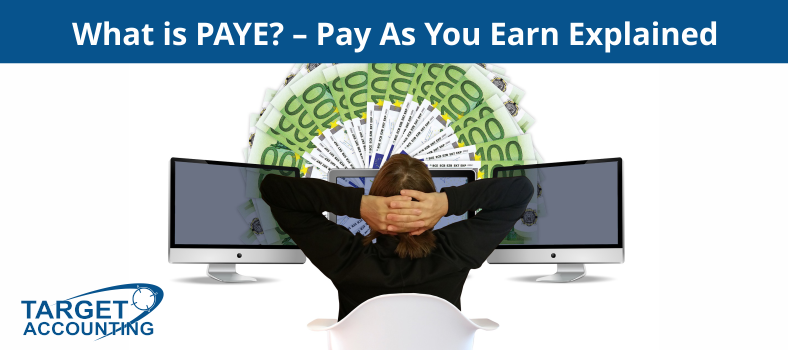PAYE stands for “Pay As You Earn” and is essentially a government system of paying income tax and national insurance contributions (NIC) across the country. The employer will tally up how much tax and NIC an employee needs to pay and deduct it before paying the wages or pension. These contributions are included in the pay slip, for the employees to double check the amount taken. Everyone, except the ones who are self-employed is required to pay PAYE tax.
Wages include sick pay, maternity or paternity pay, adoption pay and any other specialist pay. PAYE allows employees to pay tax over the whole year, every time they get paid, instead of paying all at a once. Employers are responsible for sending all the information about employees’ wages and deductions to HMRC (HM Revenue and Customs). They also need to provide employees with a payslip detailing all the information about the wages paid along with the details of the national insurance contributions, taxes and other deductions from the salary.
Basically, a tax year runs from 6th April to the 5th April of the following year. At the end of every tax year, employees will be provided with a P60 form which describes all the information about the total wages received and the amount deducted for the previous tax year.
PAYE system can also be used to pay the taxes on any taxable income a person has. For instance, if a person is paying tax on his/her occupational pension, with the help of PAYE system the tax due on State Retirement Pension can directly be deducted from the occupational pension.
In addition, the PAYE system can also be used to pay the tax due on all the other income sources including rent and untaxed interest. Besides this, other amounts that you owe to HMRC, such as tax debts from previous years; unpaid self-employed national insurance contributions or tax debts can be paid using the PAYE system.
How Is PAYE Calculated?
A tax code is used by HMRC to educate employers and pension providers on how much tax they need to deduct from the wages or pension. These PAYE codes are made up of a number and a letter.
- Number – The amount of income which may be set against tax.
- Letter – Type of allowance
There are numerous ways that an employer or pension provider can use to work out PAYE and calculate the amount they need to deduct from their staff’s salary for tax and national insurance contribution. However, it is wise to seek the help of a professional accountant or a payroll specialist to get the job done.
PAYE involves a quite complex process and an employer will need an employee’s tax code. Later, based on the annual salary of the employee, employers calculate tax and national insurance contributions they need to pay. This amount can be divided either for monthly or yearly payments.
Who Are Eligible To Register For PAYE?
If you are an employer with staff getting paid more than £113/week, you need to register for PAYE. Before every payday, you need to inform HMRC about the amount of tax and NI your every employee will be paying at the end of every month. Enrolling for PAYE ensures that your employees’ tax and NI amounts are paid.
Basically, there are two options for operating PAYE:
- You can run it yourself with your own payroll system
- Hire a payroll specialist to do it on your behalf.
PAYE registration can take up to 2 weeks. Need not to be said, you need to get registered in advance of the first pay day.
Listed below are the basic steps you need to follow while setting up your company’s payroll:
- Register your company with HMRC
- Register each employee on the payroll with HMRC
- Every time you run the payroll, your software will send the information to HMRC
- Within, the agreed time frame, you need to pay the taxes your employees’ owe to HMRC.
Payments Included In The PAYE System:
Any payment that is made to an employee is supposed to be added in the PAYE system. It includes:
- Sick pay as well as parental pay
- Expenses and benefits such as tips, bonuses and other payments
- Inducement payments and cash prizes
- Savings certificates
- Holiday payment and travel time payments
Deductions That Needs to Be Made in Employee’s Payments:
As an employer, you need to find out about the deductions required to be made from the employee’s wages, in order to comply with NI and tax regulations. This amount is calculated on the basis of the national insurance letter and the employee’s tax code.
- If the employee is due to student loan repayments, you need to deduct that too.
- Pensions as per the new government workplace pension rules
- Employees participating in Payroll giving as a charity needs to be recorded in the PAYE system
- Any child maintenance payments
Employing For The First Time? Things You Need To Do:
Recommended by HMRC, listed below are the seven things that you need to do before employing any personnel for the first time.
- Decide their wage
- Conduct background checks and ensure that they have a legal UK work right
- Determine if you need to do a DBS check
- Ensure you have employer’s liability insurance
- Provide the employee with written terms and conditions
- Register with HMRC for PAYE
- Check out, if you need to enrol your staff into a workplace pension scheme
Other Things That Needs To Be Reported To HMRC
As an employer, you need to inform HMRC when a new employee joins or when an existing employee’s circumstances change. For example, the employee gets a promotion or reaches State Pension age. At the end of every tax year, you need to run annual reports which also include informing HMRC about any benefits or expenses.


